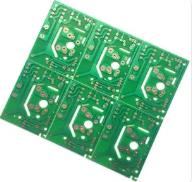Electroless copper is a very important step in the process of PCB hole metallization. Its purpose is to form a very thin conductive copper layer on the hole wall and copper surface to prepare for the subsequent electroplating. Hole wall plating is one of the common defects of PCB hole metallization, and it is also one of the items that easily cause printed circuit boards to be scrapped in batches. Therefore, solving the problem of printed circuit board plating cavities is a key control for printed circuit board manufacturers. Content, but due to the various reasons for its defects, only by accurately judging the characteristics of its defects can we effectively find a solution.
1. Hole wall plating cavity caused by PTH
PTH-induced cavities in the hole wall plating are mainly point-shaped or ring-shaped cavities. The specific reasons are as follows:
(1) The copper content of the copper sink, the concentration of sodium hydroxide and formaldehyde
The solution concentration of the copper tank is the first consideration. Generally speaking, the copper content, sodium hydroxide and formaldehyde concentration are proportional. When any of them is less than 10% of the standard value, the balance of chemical reactions will be destroyed, resulting in poor chemical copper deposition and spotting. The void. Therefore, priority is given to adjusting the potion parameters of the copper tank.
(2) The temperature of the bath liquid
The temperature of the bath also has an important influence on the activity of the solution. There are generally temperature requirements in each solution, and some of them must be strictly controlled. So pay attention to the temperature of the bath at any time.
(3) Control of activating liquid

Low divalent tin ions will cause the decomposition of colloidal palladium and affect the adsorption of palladium, but as long as the activation solution is added regularly, it will not cause major problems. The key point of the activation solution control is that it cannot be stirred with air. The oxygen in the air will oxidize the divalent tin ions. At the same time, no water can enter, which will cause the hydrolysis of SnCl2.
(4) Cleaning temperature
The cleaning temperature is often overlooked. The best cleaning temperature is above 20 degree Celsius. If it is lower than 15 degree Celsius, the cleaning effect will be affected. In winter, the water temperature becomes very low, especially in the north. Due to the low washing temperature, the temperature of the board after cleaning will also become very low. The temperature of the board cannot rise immediately after entering the copper tank, which will affect the deposition effect because the golden time for copper deposition is missed. Therefore, in places where the ambient temperature is low, pay attention to the temperature of the cleaning water.
(5) Use temperature, concentration and time of pore regulator
The temperature of the chemical liquid has strict requirements. Too high temperature will cause the decomposition of the pore modifier, lower the concentration of the pore modifier, and affect the effect of the pore. The obvious feature is the glass fiber cloth in the hole. Punctate voids appear. Only when the temperature, concentration and time of the liquid medicine are properly matched can a good hole-regulating effect be obtained, and at the same time it can save costs. The concentration of copper ions continuously accumulated in the liquid medicine must also be strictly controlled.
(6) Use temperature, concentration and time of reducing agent
The effect of reduction is to remove the potassium manganate and potassium permanganate remaining after decontamination. The out-of-control parameters of the chemical solution will affect its effect. Its obvious feature is the appearance of dotted voids at the resin in the hole.
(7) Oscillator and swing
The out-of-control of the oscillator and the swing will cause a ring-shaped cavity, which is mainly due to the inability to eliminate the bubbles in the hole, the most obvious is the small orifice plate with high thickness to diameter ratio. The obvious feature is that the cavities in the hole are symmetrical, and the copper thickness of the part with copper in the hole is normal, and the pattern plating layer (secondary copper) wraps the entire board plating layer (primary copper).
(8) Tin plating (lead tin) has poor dispersion
Due to poor solution performance or insufficient swing, the thickness of the tin-plated coating is insufficient. During the subsequent film removal and alkaline etching, the tin and copper layers in the middle of the hole are etched away, resulting in ring-shaped voids. The obvious feature is that the thickness of the copper layer in the hole is normal, there are obvious traces of etching on the edge of the fault, and the pattern plating layer does not cover the entire board (see Figure 5). In view of this situation, you can add some tinning brightener in the pickling before tinning, which can increase the wettability of the board and increase the swing amplitude at the same time.
4 Conclusion
There are many factors that cause coating voids, the most common one is PTH coating voids, which can effectively reduce the generation of PTH coating voids by controlling the relevant process parameters of the potion. However, other factors cannot be ignored. Only through careful observation and understanding of the causes of coating voids and the characteristics of defects can the problems be solved in a timely and effective manner and the quality of the products can be maintained.
PCB factories can take countermeasures according to the phenomenon of PCB hole wall coating cavities